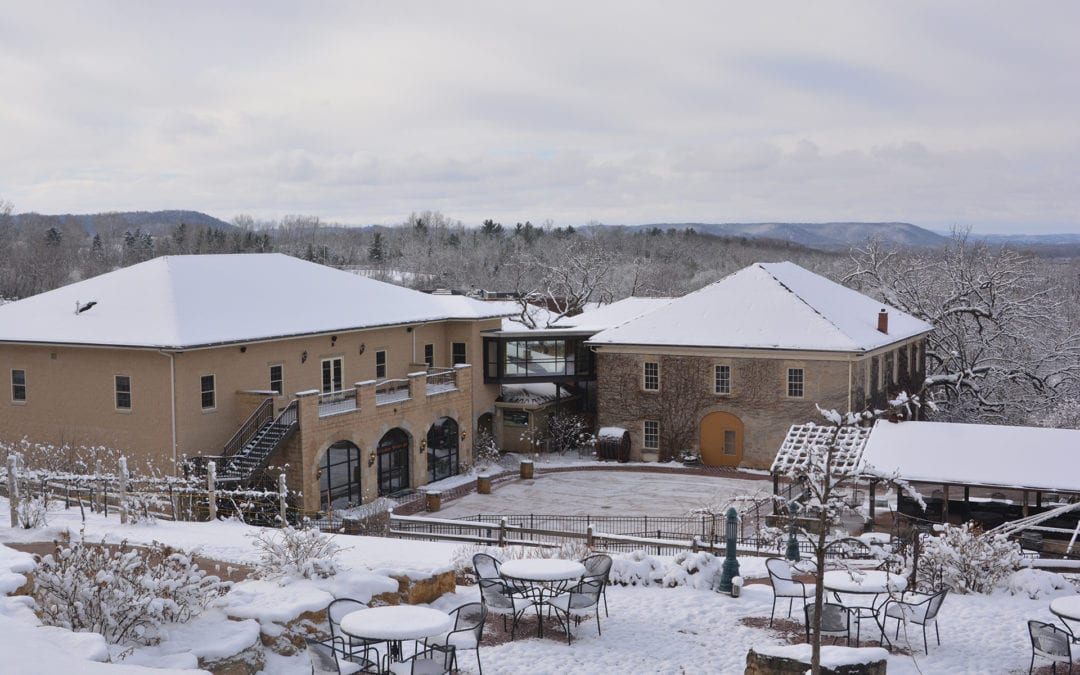Wisconsin is often overlooked when it comes to the world of wine, and its infamously long and cold winters play a large part in that misconception.
To answer some of the questions you may have about growing grapes and making wine in the Frozen Tundra – particularly with a never-ending winter like this year’s – we have put together a quick Q&A session with our Enologist and 14th generation Winemaker, Celine Coquard-Lenerz.
Q : How is it possible to grow a fruit like grapes when temperatures can range from 100 degrees in the summer months to negative 30 degrees in the winter?
A: That’s what farming in Wisconsin is all about. Though we’re winemakers, we are first and foremost grape farmers. We’ve experimented with many varieties of vines to see what would survive our extremes here, and over the years have settled on a handful of cold-hardy vines that are both pretty tolerant of pests and diseases we have to deal with and can make outstanding quality wine with fantastic aromas. These vines are tolerant of temperatures to -30F for short periods of time when in a full, healthy dormancy (let’s be honest, they do better than we do in the cold!).
Q : Do the cold temperatures affect the taste of the grapes and the wine?
A: Cold winter temperatures won’t affect the taste of the grapes. As winegrowers, we have a host of canopy management tools that are really influential from pruning in the late winter through late summer as the grapes start to ripen, deepening in color and accumulating sugar. Setting the cropload at pruning and removing excess green growth during the summer to increase sun exposure and allow the vines to concentrate on ripening the fruit will also influence the aromas in the grapes that will be expressed in the wine.
Q : What is Ice Wine and how is it unique from other wines?
A: The nectar of the vines, Ice Wine is a deeply aromatic, sweet wine that is made from fruit picked in the winter. Our St. Pepin grapes, native to Wisconsin, are left to ripen past our usual harvest in September, and allowed to naturally experience the freezing and thawing cycles that happen as we approach the winter season. When the grapes are fully frozen (around 10F) in December, we hand harvest every cluster, and then press the grapes while frozen from the field, allowing just the sweet concentrated grape sugars to collect and ferment over a period of a few weeks. The resulting wine is a rich expression of the beautiful cold that makes our seasons beautiful.
Q : Is the current April snowfall going to affect the fruit crop and this year’s vintage?
A: We hope that spring comes soon so the growing season can get underway, but we are thankful for the extra precipitation the snow has brought! So far, it’s been a slow, cool start to the growing season, so the snow shouldn’t affect the crop.
Q : Is a late frost worse than a long winter for the health of the vines?
A: A late frost has immediate and devastating results for the fruit crop for just that one season. A long winter, such as this one, that has been rather mild is not a problem, providing that the growing season will be long enough to fully ripen the crop. A long winter with severe cold towards spring as vines are leaving dormancy however, can cause death in the vines—as sap starts flowing to the upper portions of the vines, the cold can form ice in the wood causing it to split. Dead vines have to be replaced and trained over the next 4 years, after which the first crop can finally be harvested.
Q : Do old vines fare better than new vines during turbulent or inclement weather?
A: Vines are all affected by turbulent weather, no matter their age, as whipping winds and hail can damage the leaves or rip shoots off, leading to a loss of fruit. When it comes to winters, old vines in good health will fare better than young vines because they have more reserves in their roots.
Q : What months are the most critical for success during the grape-growing process?
A: Because winemaking starts in the vineyard, we see every month as critical to the success of the vines. We do our best in working the vines to grow the best crop for each wine while maintaining the highest health of the vine and most productive longevity, but Mother Nature ultimately dictates the direction our management practices can take, so every year we remain flexible and learn something new. We are always thinking about the process.
Follow us on…
Facebook and Instagram – @wollersheimwine and @wollersheimdistillery
Twitter – @wollersheimwine and @wollersheimdist


